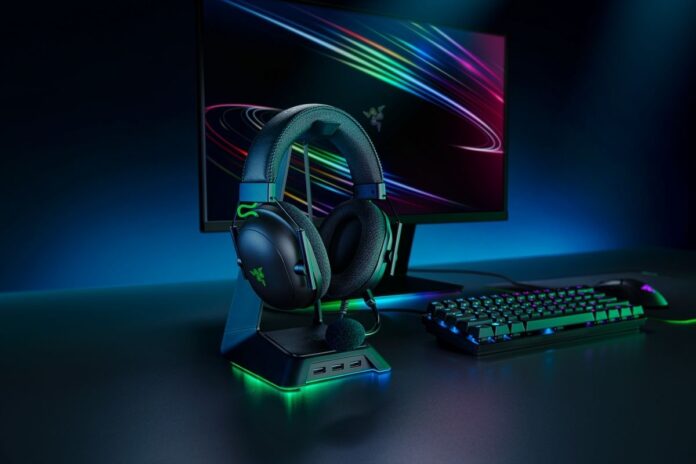You might have heard of the gaming headset trend, where companies like Razer, Turtle Beach, Astro, and others have come out with headsets that resemble the look of a video game console. While many of these headsets have a lot of hype surrounding them, others have fallen short and left gamers disappointed.
We received a lot of questions for our Gaming Headphones Guide, so we decided to create a new article focusing on mixing Monitor headphones with Gaming Audio. Many gamers often wonder if Monitor Headphones are compatible with games. So, we decided to investigate this topic, and summarize our findings into three key points.
You may have heard about gaming headsets before, but what you may not have considered is how they actually perform. We put the popular Logitech G933 7.1 Surround Sound Gaming Headset to the test, and here’s what we found.
When people ask us what they should purchase to improve their competitive gaming, we always recommend a decent set of headphones. However, there are a variety of headphones accessible right now, leaving gamers to ponder how best to spend their money.
We’ll try to address that question by examining if and why monitor headphones are useful for gaming.
This article is part of a partnership with AudiphileHaven.com.
Is Gaming with Monitor Headphones a Good Idea?
Yes. Gaming with monitor headphones is a fantastic idea. However, they aren’t as excellent as gaming headphones for gaming. Monitor headphones, often known as studio headphones, are used to analyze music on a technical level. Gaming headphones, on the other hand, are designed to concentrate on particular noises, such as opponent footsteps.
Gaming headphones, on the whole, are better for gaming. It should come as no surprise that both kinds of headphones are intended for distinct reasons.
If you already have monitor headphones or intend to use them to mix music, there’s no reason why you can’t use them for gaming.
Why?
We’ll go into more detail about this further down, but the basic line is that it all boils down to sound frequencies.
Specific noises, such as opponent footsteps, are emphasized using gaming headphones. This enables them to be heard clearly over gunshots and car noise.
On the other hand, monitor headphones are flat. There is no emphasis or de-emphasis on any particular sound. This enables producers to hear songs as close to the original recording as possible.
There are a few additional considerations, such as studio imaging, but that is the foundation of why gaming headphones are preferable to monitor headphones for gaming.
What are Monitor Headphones and How Do I Use Them?
Headphones for monitoring and studio usage are interchangeable. For our purposes, they’re the same.
We’re referring to the headphones that music producers utilize. Imagine a step up from getting a decent set of headphones to the point where you identify instruments you didn’t know were on a song before. Monitor headphones are exactly what they sound like.
They’re made to replicate the music’s original sound as closely as possible.
The term “monitor headphones” refers to the practice of listening to music while recording. This method entails dissecting individual sounds on a recording on a technical level. As a result, each individual instrument must be heard.
Monitoring headphones feature a neutral frequency response, which means they don’t accentuate or de-emphasize particular frequencies. It’s the polar opposite of the “Beats” headphones, which dominated the market with their bass increase.
The Frequency Range of Monitor Headphones Is Wide and Flat
For high quality headphones, the typical frequency range is 20 Hz to 20,000 Hz. This implies the headphones can generate a deep base frequency of 20 Hz and a treble frequency of 20,000 Hz. It’s the sound range that the headphones can properly reproduce.
Monitor headphones may produce sounds in this range, and occasionally much higher. These headphones’ expanded frequency range improves the listening experience by generating additional sounds that match the original recording.
This broad range also enables for a clear and distinct distinction between high and low sounds, rather of them all merging into one tone.
That’s when a frequency range with a flat frequency range comes into play. Unlike the previously stated “bass enhanced” headphones, this keeps the sound levels constant no matter what Hz level the headphones are generating at any one time throughout a track.
Producers almost exclusively use monitor headphones.
Monitor headphones aren’t advised for everyday listening, even for music fans. The blandness of the music is due to the flat nature of the range frequency. You won’t experience the adrenaline-pumping highs and lows that you’d expect from excellent music.
That’s not to suggest you can’t listen to music using monitor or studio headphones on a daily basis, but the technical aspect detracts from the enjoyment of the song.
However, we’re not interested in using monitor headphones to listen to music. We’re looking at them through the lens of gaming. We’re not as concerned with the game’s sound quality as we are with locating the sound source.
Given all of this, you wouldn’t be wrong to believe studio headphones are ideal for competitive gaming. The truth is a bit less black and white than that in reality.
Monitor Headphones vs. Gaming Headphones: What’s the Difference?
There are a few key distinctions between monitor headphones and gaming headphones. The major difference is the flat frequency range of studio headphones vs the curves seen on gaming headphones.
Headphones for gaming aren’t flat.
Monitor headphones, as previously stated, are flat to match the sound of the original recording. That’s wonderful for making music, but not so good when we need some sounds to be louder than others.
Explosions and footsteps are two famous instances of this.
While the sounds of explosions are useless for our purposes in competitive gaming, there’s no denying that they sound amazing. Due to the accentuated bass, these explosions will sound much more powerful and deadly with gaming headphones than with studio headphones.
However, the importance of one’s footprints is immeasurable.
Boosted highs enable enemy footsteps to ring out clearly, similar to how boosted bass makes explosions sound louder. The sound of footsteps would be lost in the noise of gunfire and activity if you wore monitor headphones. They’re clear and loud with gaming headphones. This is why gaming headphones are so popular.
However, it’s not only the footfall that are difficult to hear. They’re also more difficult to locate.
The sound stage of gaming headphones is very small. The different pieces of audio you hear are kept close together in limited sound stages, giving you greater positional precision on where each sound is originating from. Monitor headphones, on the other hand, are more likely to have a wide soundstage. This makes the audio components more spread out and “airy,” making pinpointing more difficult.
This distinction may also be seen in imaging. Sound localization is closely linked to imaging. The term “surround sound” is often used by gaming headphone makers to describe this.
Simply said, if anything happens to the left of your character, it will be heard via the left earphone, and vice versa. Monitor headphones offer great imaging, but their broad sound stage restricts performance in this area when compared to gaming headphones with more limited specs.
Other Technical Dissimilarities
The most important distinctions between gaming and monitor headphones are listed above. These considerations lead us to believe that gaming headphones are superior than monitor headphones for gaming. However, they aren’t the only distinctions. There are a few more to be found. When comparing the two, for example, compatibility may be a problem. When it comes to audio jacks, this is especially true.
3.5mm audio jacks are used by the majority of gaming headphones. This is the typical size of an industry. Your PlayStation controllers and PC connections are also built to suit that size. 6.5mm jacks, on the other hand, are used in monitor headphones. These aren’t going to fit into any 3.5mm ports.
Adapters, of course, can be used to get around this. However, compared to the plug-and-play convenience of gaming headsets, this additional step may be inconvenient.
Finally, we must consider comfort. In this respect, both monitor headphones and gaming headphones are excellent, but they are not on an equal basis.
Monitor headphones are designed for long-term usage at all levels. Producers may work for up to 10 hours in a single sitting, thus the headphones are built to keep them comfortable.
While this is true for high-end gaming headsets, it is not true for cheap headsets. You won’t get the same degree of comfort with a gaming headset for less than $100 as you would from a studio set for the same price.
FAQs
Can I Listen to Music While Wearing Monitor Headphones?
You are free to do so, but you should not. They’re great for mixing and producing music, but not so much for casual listening.
This is due to the fact that monitor headphones do not amplify any frequencies. The high notes and deep bass tones that you associate with your favorite music will be less vivid than with headphones intended for casual usage.
Monitor Headphones vs Gaming Headphones: Which is Better for Gaming?
Headphones for gaming. Because of the difference in design, gaming headphones may emphasize key noises as well as the direction from which they are originating.
What are the Functions of Monitor Headphones?
Music producers utilize monitor headphones, often known as studio headphones, while working on beats and songs. They provide listeners an in-depth experience that enables them to concentrate on individual instruments.
I was asked by a reader recently if monitor headphones were good for gaming. Generally speaking, they are decent enough if you want to hear your game’s audio while using a computer. But if you’re going to want to be bothered with the wires and/or the noise they make while being plugged in, then you’ll want to play your game using game-specific headset with your console, computer, or mobile device.. Read more about best studio headphones for gaming 2024 and let us know what you think.
{“@context”:”https://schema.org”,”@type”:”FAQPage”,”mainEntity”:[{“@type”:”Question”,”name”:”Are studio monitoring headphones good for gaming?”,”acceptedAnswer”:{“@type”:”Answer”,”text”:”
Studio monitoring headphones are a good choice for gaming because they allow you to hear the games sound in detail.”}},{“@type”:”Question”,”name”:”Which headphones are good for gaming?”,”acceptedAnswer”:{“@type”:”Answer”,”text”:”
The best headphones for gaming are the ones that you can hear your game audio and your chat audio at the same time.”}},{“@type”:”Question”,”name”:”Why do gamers use studio headphones?”,”acceptedAnswer”:{“@type”:”Answer”,”text”:”
Studio headphones are designed to provide a more accurate sound reproduction. This is because they have flat, wide-range drivers that can reproduce all frequencies of sound in the audible range.”}}]}
Frequently Asked Questions
Are studio monitoring headphones good for gaming?
Studio monitoring headphones are a good choice for gaming because they allow you to hear the games sound in detail.
Which headphones are good for gaming?
The best headphones for gaming are the ones that you can hear your game audio and your chat audio at the same time.
Why do gamers use studio headphones?
Studio headphones are designed to provide a more accurate sound reproduction. This is because they have flat, wide-range drivers that can reproduce all frequencies of sound in the audible range.
Related Tags
This article broadly covered the following related topics:
- gaming headset vs headphones
- gaming headset vs audiophile headphones
- best headphones for gaming
- studio headphones for gaming
- audiophile gaming setup




